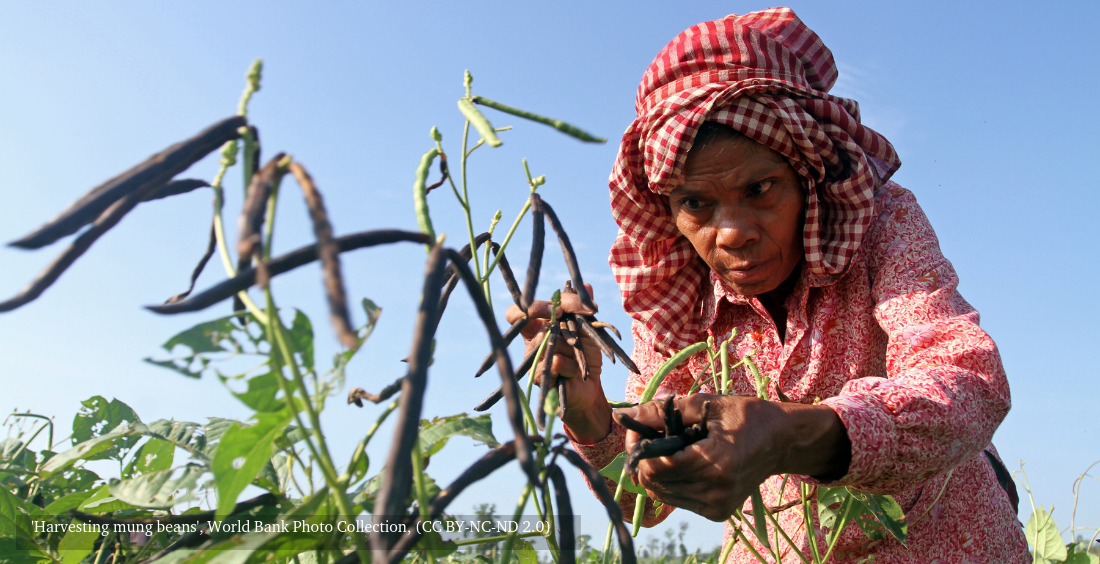One day people may wonder how anyone thought that lending money at high interest rates would empower the poor. Yet since the 1980s, the small, high-interest loans that were initially known as microcredit, have been a staple of global development agencies’ toolkits. The non-profit microfinance sector commercialised and became today’s global financial inclusion industry, which specialises in channelling the money of the have-much’s to the have-not’s. For having the idea, in 2006, Muhammad Yunus, the founder of Bangladesh’s Grameen Bank, won the Nobel Peace Prize – the only banker to have ever done so.

‘Harvesting mung beans’, World Bank Photo Collection, (CC BY-NC-ND 2.0)
A recent report from the human rights group LICADHO highlights the case of at least one million people in Cambodia have been driven by poverty to pledge their land and houses as collateral for loans from microfinance institutions (MFIs). Is this a tragedy that could have been avoided if the international community had heeded the long-apparent warning signs of microfinance failing the poorest?
The recent reports from Cambodia confirm what has been rumoured for years in industry circles. According to one of Cambodia’s leading human rights organisations, at least one million people have been driven by poverty to pledge their land and houses as collateral for loans from micro-finance institutions (MFIs for short), most of which are for-profit and owned by foreign investors. These MFIs lend money in return for a promise to repay, with interest, and a land title as security. The clients sign contracts, which they often cannot read, with a thumbprint, agreeing that if they cannot repay the MFI will keep their assets.
Many clients have already either lost their land or been coerced into selling it, ending up forced to migrate or descend into debt-bonded labour, or are at risk. Their children are sent to work instead of going to school. In some cases, MFIs have attached “for sale” signs to clients’ houses as a pressure tactic. This land grabbing has a bitter taste in a small South-East Asian country where Pol Pot’s genocidal Khmer Rouge forcibly relocated millions of people into collectivised agriculture, in the 1970s.
Yet for careful observers of the financial inclusion industry, the events in Cambodia should come as no surprise. Several factors have fatefully converged. First, MFIs have shifted from their erstwhile collateral-free group lending model towards individual loans backed up by the threat of confiscating borrowers’ meagre assets. Second, the country of only 15 million people – the poorest in southeast Asia – has become the world’s fourth-largest microfinance market. The average MFI loan size has grown four times faster than household incomes, and microfinance institution has become Cambodia’s biggest bank. Third, as the Cambodian government has become increasingly concerned, it has sought to stem the flow of microloans by capping the interest rate on (new) loans at 18 per cent, in 2017. But this may have made things worse by leading MFIs to drive down costs by giving even bigger loans to the same clients, charging more up-front fees instead of interest and, crucially, banking on the possibility of gaining borrowers’ assets instead of repayments.
In a particularly tragic series of events, within a single month in 2010, dozens of overindebted borrowers in the Indian state of Andhra Pradesh were driven to suicide. They were advised by MFI agents to take their own lives so that a compulsory life insurance would pay off the loan. At that time, Andhra Pradesh was the world’s fastest growing microfinance market. Cambodia’s microfinance sector, which is for-profit and mostly owned by foreign investors, appears to be at the height of a massive lending bubble. But to treat Cambodia as the ‘perfect storm’ would miss a key point: this story is all too familiar. In 2008, MFIs in Bosnia, Nicaragua, and Pakistan had to write off hundreds of millions of dollars worth of loans that became unrecoverable, after in Nicaragua, aggrieved borrowers even attacked and burnt MFI offices. In Morocco, the Arab Spring gave rise to a women’s protest movement calling itself ‘Victims of Microcredit’, whose leaders were sued by MFIs and dealt prison sentences.
In this light, cases such as that of the Cambodian cassava farmer who, under pressure from seven different MFIs, has sent his six children to work as labourers, sold half of his land, and indebted himself to moneylenders, sound tragically familiar. As poignant as the reports from Cambodia may be, they should not distract from the fact that many millions of poor people around the world struggle to make ends meet while bearing the burden of microfinance loans offered. Despite this, donors have promoted microfinance and financial inclusion with the good intention of empowering the poor, particularly women, by channelling the capital of foreign investors to them. But this system, instead of alleviating poverty, has ended up financialising poverty.
So what needs to be done now? Firstly, and most urgently, land losses need to be stopped and effective escape routes for distressed clients in Cambodia need to be opened up. An immediate halt to coerced land sales needs to be enforced and an independent commission set up to adjudicate debtors’ rights against lenders’ claims. Cambodia is a flawed, illiberal democracy, and its legal system is inaccessible to most poor people, so their welfare depends on effective pressure from the international community. Second, a fact-finding mission needs to investigate both the scale of the abuses and determine responsibility. The LICADHO report suggests many more of Cambodia’s 2.4 million microfinance borrowers may be affected. It is crucial to find out how many exactly. The mission also needs to establish who among the different actors in the financial inclusion industry, from loan agents to MFI bosses, investor groups and development funders, needs to be held accountable, because the global financial inclusion industry, operating largely on goodwill, has so far escaped regulation. In the name of its supposed beneficiaries, it is time for effective oversight.